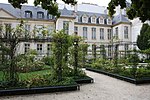Saint-Sébastien–Froissart (Paris Métro)
Paris Métro line 8Paris Métro stations in the 11th arrondissement of ParisParis Métro stations in the 3rd arrondissement of ParisParis Métro stubsRailway stations in France opened in 1931

Saint-Sébastien–Froissart (French pronunciation: [sɛ̃ sebastjɛ̃ fʁwasaʁ]) is a station on line 8 of the Paris Métro, named after the nearby streets of Rue de Saint-Sébastien and the Rue Froissart. The station opened on 5 May 1931 with the extension of the line from Richelieu–Drouot to Porte de Charenton. The Rue de Saint-Sébastien was named after Saint Sebastian. The Rue Froissart was named after the poet and writer Jean Froissart (ca 1337–1400).
Excerpt from the Wikipedia article Saint-Sébastien–Froissart (Paris Métro) (License: CC BY-SA 3.0, Authors, Images).Saint-Sébastien–Froissart (Paris Métro)
Boulevard Beaumarchais, Paris 3rd Arrondissement (Paris)
Geographical coordinates (GPS) Address Nearby Places Show on map
Geographical coordinates (GPS)
| Latitude | Longitude |
|---|---|
| N 48.86048 ° | E 2.367358 ° |
Address
Sandro
Boulevard Beaumarchais 105
75003 Paris, 3rd Arrondissement (Paris)
Ile-de-France, France
Open on Google Maps










